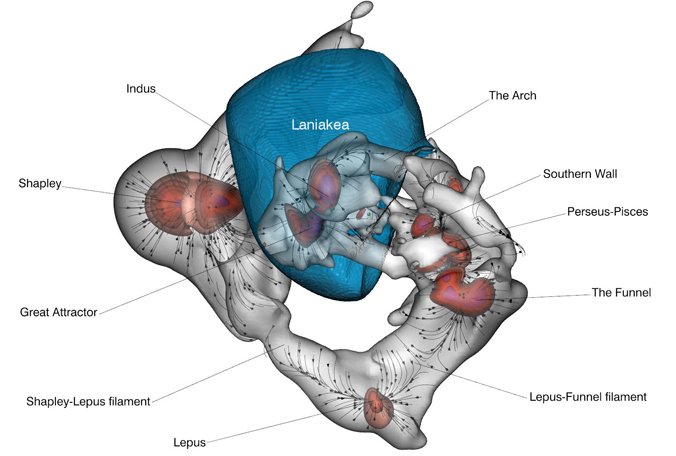
The cosmic web—the distribution of matter on the largest scales in the universe—has usually been defined through the distribution of galaxies. Now, a new study published in The Astrophysical Journal, by a team of astronomers from France, Israel and Hawaiʻi demonstrates a novel approach. Instead of using galaxy positions, they mapped the motions of thousands of galaxies. Because galaxies are pulled toward gravitational attractors and move away from empty regions, these motions allowed the team to locate the denser matter in clusters and filaments and the absence of matter in regions called voids.
Matter was distributed almost homogeneously in the very early universe, with only miniscule variations in density. Over the 14 billion year history of the universe, gravity has been acting to pull matter together in some places and leave other places more and more empty. Today, the matter forms a network of knots and connecting filaments referred to as the cosmic web. Most of this matter is in a mysterious form, the so-called “dark matter.” Galaxies have formed at the highest concentrations of matter and act as lighthouses illuminating the underlying cosmic structure.
The newly defined cosmic velocity web defines the structure of the universe from velocity information alone. In those regions with abundant observations, the structure of the velocity web and the web inferred from the locations of the galaxy lighthouses are similar. This agreement provides strong confirmation of the fundamental idea that structure developed from the growth of initially tiny fluctuations through gravitational attraction.

The cosmic velocity web analysis was led by Daniel Pomarede, Atomic Energy Center, France, with the collaboration of Helene Courtois at the University of Lyon, France; Yehuda Hoffman at the Hebrew University, Israel; and Brent Tully at the University of Hawaiʻi’s Institute for Astronomy.
“With the motions of the galaxies, we can infer where all of the mass is located: the galaxies and the five times more abundant transparent matter (usually wrongly called dark matter). This total gravitating mass, together with the expansion of the universe, is responsible for the motions that create the architecture of the universe. The gravity from galaxies alone cannot create this network we see,” said Courtois.
Tully adds, “Moreover, a wide swath of the universe is hidden behind the obscuring disk of our own Milky Way galaxy. Our reconstruction of structure with the velocity web is revealing for the first time filaments of matter that stretch all the way around the sky and are easily followed through these regions of obscuration.”
For more on the discovery, read the Institute for Astronomy’s news release.
—By Roy Gal

